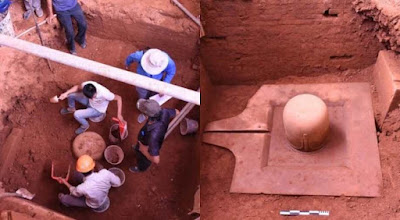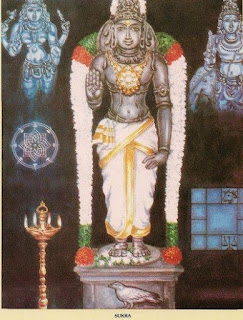1100-year-old Shiva Lingam Found in My Son Vietnam Temple
The Archaeological Survey of India (ASI) on Wednesday unearthed a stunning monolithic sandstone Shiva Linga of the 9th Common Era from Cham temple Vietnam
The Archaeological Survey of India on Wednesday(27 May 2020) unearthed a monolithic sandstone Shiva Linga of the 9th Common Era during its conservation project. The structure was excavated from the Cham Temple Complex at the My Son Sanctuary of Vietnam. It is a monolithic structure with decorative patterns of very exquisite cultural value. Before this, six other Shiva Lingas have already been recovered in the My Son Temple complex.
Praising the ASI on the discovery, External Affairs Minister S Jaishankar said that the finding reaffirms a “civilizational connect” between the devotees of Lord Shiva around the world. He tweeted photos from the excavation and recalled his pleasant visit to the sanctuary in 2011.
The temple complex was built in the 9th century A.D. under the reign of King Indravarman II who also built the famous Dong Duong Buddhist Monastery in Quang Nam Province. French experts in 1903-1904 had discovered the temple complex in a dilapidated condition. During excavations at that time, the French archaeologists had described the presence of one Shivalinga in Group ‘A’ at the temple site. However, due to limited excavation capability at that time, it could not be recovered. Subsequently, political disturbances and wars in Vietnam led to further destruction of the temple complex.
A 4-member team of Archaeological Survey of India (ASI) has been engaged in the fourth season of restoration/conservation work (annual work schedule of Jan-Jun 2020) at the world heritage site at My Son in Quang Nam Province of Vietnam. Over the previous three seasons, ASI has restored temples in Groups ‘K’ and ‘H’ and presently the work is under progress for temples in Group ‘A’.
The Archaeological Survey of India on Wednesday(27 May 2020) unearthed a monolithic sandstone Shiva Linga of the 9th Common Era during its conservation project. The structure was excavated from the Cham Temple Complex at the My Son Sanctuary of Vietnam. It is a monolithic structure with decorative patterns of very exquisite cultural value. Before this, six other Shiva Lingas have already been recovered in the My Son Temple complex.
Praising the ASI on the discovery, External Affairs Minister S Jaishankar said that the finding reaffirms a “civilizational connect” between the devotees of Lord Shiva around the world. He tweeted photos from the excavation and recalled his pleasant visit to the sanctuary in 2011.
The temple complex was built in the 9th century A.D. under the reign of King Indravarman II who also built the famous Dong Duong Buddhist Monastery in Quang Nam Province. French experts in 1903-1904 had discovered the temple complex in a dilapidated condition. During excavations at that time, the French archaeologists had described the presence of one Shivalinga in Group ‘A’ at the temple site. However, due to limited excavation capability at that time, it could not be recovered. Subsequently, political disturbances and wars in Vietnam led to further destruction of the temple complex.
A 4-member team of Archaeological Survey of India (ASI) has been engaged in the fourth season of restoration/conservation work (annual work schedule of Jan-Jun 2020) at the world heritage site at My Son in Quang Nam Province of Vietnam. Over the previous three seasons, ASI has restored temples in Groups ‘K’ and ‘H’ and presently the work is under progress for temples in Group ‘A’.
Survei Arkeologi India (ASI) pada hari Rabu menemukan batu pasir monolitik Shiva Linga yang menakjubkan dari Era Umum ke-9 dari kuil Cham Vietnam
Survei Arkeologi India pada hari Rabu (27 Mei 2020) menemukan batu pasir monolitik Siwa Lingga dari Era Umum ke-9 selama proyek konservasi. Strukturnya digali dari Kompleks Kuil Cham di My Son Sanctuary of Vietnam. Ini adalah struktur monolitik dengan pola dekoratif dengan nilai budaya yang sangat indah. Sebelum ini, enam Lingiva Siwa lainnya telah ditemukan di kompleks Kuil My Son.
Memuji ASI atas penemuan itu, Menteri Luar Negeri S Jaishankar mengatakan bahwa temuan ini menegaskan kembali "hubungan peradaban" antara para penyembah Dewa Siwa di seluruh dunia. Dia tweeted foto dari penggalian dan mengingat kunjungannya yang menyenangkan ke tempat kudus pada tahun 2011.
Kompleks candi dibangun pada abad ke-9 M di bawah pemerintahan Raja Indravarman II yang juga membangun Biara Buddha Dong Duong yang terkenal di Provinsi Quang Nam. Pakar Perancis pada 1903-1904 telah menemukan kompleks candi dalam kondisi bobrok. Selama penggalian pada waktu itu, para arkeolog Prancis telah menggambarkan keberadaan satu Shivalinga di Grup 'A' di lokasi kuil. Namun, karena kemampuan penggalian yang terbatas pada waktu itu, itu tidak dapat dipulihkan. Selanjutnya, gangguan politik dan perang di Vietnam menyebabkan penghancuran lebih lanjut dari kompleks kuil.
Sebuah tim beranggotakan 4 orang dari Survei Arkeologi India (ASI) telah terlibat dalam musim keempat pekerjaan restorasi / konservasi (jadwal kerja tahunan Januari-Juni 2020) di situs warisan dunia di My Son di Provinsi Quang Nam di Vietnam. Selama tiga musim sebelumnya, ASI telah memulihkan kuil di Grup ‘K’ dan ‘H’ dan saat ini pekerjaan sedang berlangsung untuk kuil-kuil di Grup ‘A’.
இந்திய தொல்பொருள் ஆய்வு மையம் (ஏ.எஸ்.ஐ) புதன்கிழமை சாம் கோயில் வியட்நாமில் இருந்து 9 வது பொது சகாப்தத்தின் ஒரு அதிசயமான ஒற்றை மணற்கல் சிவலிங்கத்தை கண்டுபிடித்தது.
இந்திய தொல்பொருள் ஆய்வு நிறுவனம் புதன்கிழமை (27 மே 2020) அதன் பாதுகாப்பு திட்டத்தின் போது 9 வது பொது சகாப்தத்தின் ஒரு ஒற்றைக் மணற்கல் சிவலிங்கத்தைக் கண்டுபிடித்தது. வியட்நாமின் மை சோன் சரணாலயத்தில் உள்ள சாம் கோயில் வளாகத்திலிருந்து இந்த அமைப்பு தோண்டப்பட்டது. இது மிகவும் நேர்த்தியான கலாச்சார மதிப்பின் அலங்கார வடிவங்களைக் கொண்ட ஒரு ஒற்றைக் கட்டமைப்பாகும். இதற்கு முன்னர், எனது மகன் கோயில் வளாகத்தில் மேலும் ஆறு சிவலிங்கங்கள் ஏற்கனவே மீட்கப்பட்டுள்ளன.
இந்த கண்டுபிடிப்பு குறித்து ஐ.எஸ்.ஐ.யைப் பாராட்டிய வெளிவிவகார அமைச்சர் எஸ்.ஜெய்சங்கர், இந்த கண்டுபிடிப்பு உலகெங்கிலும் உள்ள சிவபெருமானின் பக்தர்களுக்கிடையில் ஒரு "நாகரிக தொடர்பை" மீண்டும் உறுதிப்படுத்துகிறது என்றார். அகழ்வாராய்ச்சியிலிருந்து புகைப்படங்களை ட்வீட் செய்த அவர், 2011 ல் சரணாலயத்திற்கு தனது இனிமையான வருகையை நினைவு கூர்ந்தார்.
இந்த கோயில் வளாகம் 9 ஆம் நூற்றாண்டில் ஏ.டி. மன்னர் இரண்டாம் இந்திரவர்மன் ஆட்சியின் கீழ் கட்டப்பட்டது, இவர் குவாங் நாம் மாகாணத்தில் புகழ்பெற்ற டோங் டுவோங் புத்த மடாலயத்தையும் கட்டினார். 1903-1904 ஆம் ஆண்டில் பிரெஞ்சு வல்லுநர்கள் கோயில் வளாகத்தை பாழடைந்த நிலையில் கண்டுபிடித்தனர். அந்த நேரத்தில் அகழ்வாராய்ச்சியின் போது, பிரெஞ்சு தொல்பொருள் ஆராய்ச்சியாளர்கள் கோவில் இடத்தில் ‘ஏ’ குழுவில் ஒரு சிவலிங்கர் இருப்பதை விவரித்தனர். இருப்பினும், அந்த நேரத்தில் குறைந்த அகழ்வாராய்ச்சி திறன் காரணமாக, அதை மீட்டெடுக்க முடியவில்லை. அதைத் தொடர்ந்து, வியட்நாமில் ஏற்பட்ட அரசியல் குழப்பங்களும் போர்களும் கோயில் வளாகத்தை மேலும் அழிக்க வழிவகுத்தன.
வியட்நாமின் குவாங் நாம் மாகாணத்தில் உள்ள எனது மகனில் உள்ள உலக பாரம்பரிய தளத்தில், இந்திய தொல்பொருள் ஆய்வு மையத்தின் (ஏ.எஸ்.ஐ) 4 பேர் கொண்ட குழு, மறுசீரமைப்பு / பாதுகாப்பு பணிகளின் நான்காவது சீசனில் (ஜனவரி-ஜூன் 2020 ஆண்டு வேலை அட்டவணை) ஈடுபட்டுள்ளது. முந்தைய மூன்று பருவங்களில், ஏ.எஸ்.ஐ குழுக்கள் ‘கே’ மற்றும் ‘எச்’ கோயில்களை மீட்டெடுத்துள்ளது, தற்போது ‘ஏ’ குழுவில் உள்ள கோயில்களுக்கான பணிகள் நடந்து வருகின்றன.





Comments
Post a Comment